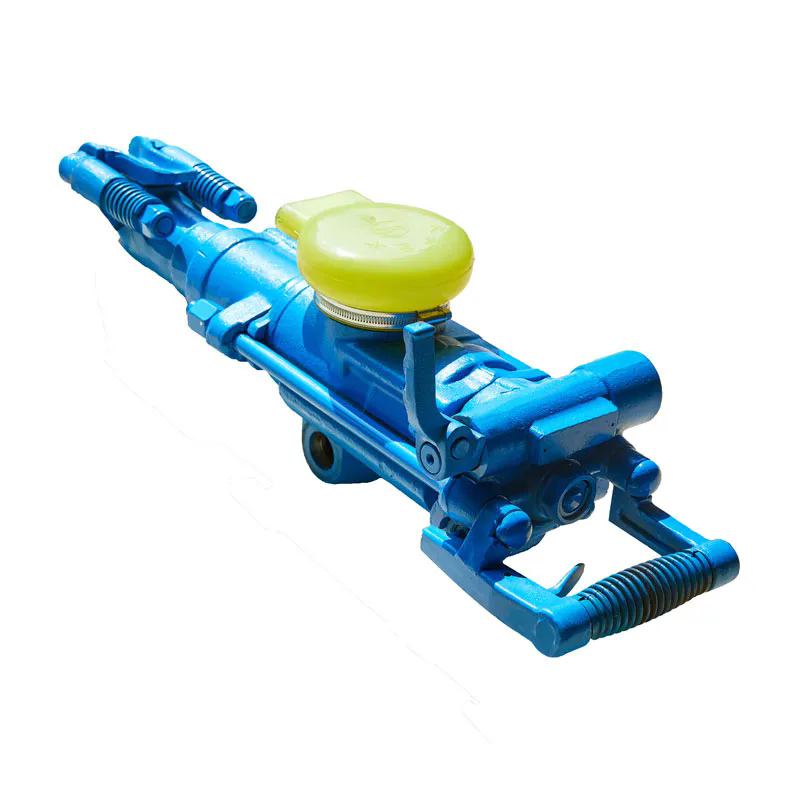Unleashing Power and Precision: A Comprehensive Guide to Handheld Pneumatic Rock Drills
2024-08-19
In the world of construction and mining, efficiency and durability are key to tackling tough tasks. Among the essential tools for breaking through rock and hard materials is the handheld pneumatic rock drill. This powerful equipment combines the force of compressed air with innovative design to deliver precise and effective drilling performance. In this blog, we’ll explore the features, benefits, applications, and maintenance of handheld pneumatic rock drills, and why they remain a cornerstone in heavy-duty drilling operations.
What is a Handheld Pneumatic Rock Drill?
A handheld pneumatic rock drill is a tool powered by compressed air that is designed to drill into hard rock and concrete. Unlike electric or hydraulic drills, pneumatic rock drills use the energy from compressed air to drive the drill bit, making them particularly effective for tasks that require high impact and penetration. These drills are commonly used in mining, construction, and quarrying industries where robust and reliable drilling equipment is essential.
Key Features of Handheld Pneumatic Rock Drills
1. Powerful Impact: Pneumatic rock drills are known for their impressive impact force, which allows them to break through tough rock and concrete with ease. This power is generated by the high-pressure air delivered to the drill’s piston.
2. Durable Construction: Built to withstand harsh working conditions, handheld pneumatic rock drills are constructed from high-quality materials such as forged steel and alloy metals. This durability ensures that the drill can endure the rigors of heavy use.
3. Versatile Bit Compatibility: These drills can accommodate a variety of drill bits, including cross bits, button bits, and chisel bits, allowing them to perform different types of drilling tasks.
4. Ergonomic Design: Despite their power, many handheld pneumatic rock drills are designed with ergonomics in mind. Features such as cushioned handles and balanced weight distribution help reduce operator fatigue and improve control.
5. Adjustable Speed and Pressure: Many models come with adjustable settings for speed and air pressure, providing flexibility to adapt to different drilling requirements and materials.
6. Safety Features: Safety is paramount in drilling operations. Handheld pneumatic rock drills often include features such as vibration dampening, safety guards, and automatic shut-off mechanisms to protect the operator and enhance safety.
Benefits of Handheld Pneumatic Rock Drills
1. High Efficiency: The combination of compressed air and powerful impact enables handheld pneumatic rock drills to complete drilling tasks quickly and efficiently, reducing overall project time.
2. Robust Performance: These drills are designed to handle the toughest materials, including hard rock and concrete. Their reliability makes them a preferred choice for challenging drilling conditions.
3. Portability: Being handheld, these drills offer mobility and ease of use in various locations, whether on-site at a construction project or in a mining operation.
4. Reduced Heat Generation: Unlike electric drills, pneumatic drills generate less heat during operation, which can be beneficial in preventing overheating and extending the life of the drill.
5. Low Maintenance: Pneumatic rock drills require less maintenance compared to their electric or hydraulic counterparts. With proper care, they can offer long-lasting performance with minimal downtime.
Applications of Handheld Pneumatic Rock Drills
1. Mining: In the mining industry, handheld pneumatic rock drills are used for drilling blast holes, accessing ore deposits, and performing secondary blasting operations.
2. Construction: Construction workers use these drills for tasks such as breaking through concrete, creating holes for anchors, and removing old or damaged material.
3. Quarrying: In quarrying operations, pneumatic rock drills are employed to extract stone and aggregate by drilling and blasting rock formations.
4. Demolition: For demolition projects, these drills are used to break up concrete structures and prepare surfaces for further demolition or renovation.
5. Tunneling: In tunnel construction, handheld pneumatic rock drills play a crucial role in drilling through rock and other hard materials to create tunnel passages.
Maintenance and Care
To ensure optimal performance and longevity of your handheld pneumatic rock drill, follow these maintenance tips:
1. Regular Cleaning: Keep the drill clean and free from debris. Regularly inspect and clean air filters, vents, and external components to ensure proper airflow and operation.
2. Lubrication: Proper lubrication of moving parts is essential to reduce friction and wear. Follow the manufacturer’s guidelines for lubrication intervals and types of lubricants.
3. Inspect Components: Regularly check for signs of wear or damage to drill bits, handles, and other components. Replace worn or damaged parts promptly to avoid operational issues.
4. Air Supply Maintenance: Ensure that the air supply system is well-maintained and free from leaks. Properly maintain air compressors and hoses to ensure consistent performance.
5. Operator Training: Proper training for operators can prevent misuse and reduce the risk of accidents. Ensure that operators are familiar with the drill’s features and safety procedures.
Conclusion
Handheld pneumatic rock drills are indispensable tools in industries that require powerful and reliable drilling solutions. Their combination of robust performance, durability, and efficiency makes them a go-to choice for tackling tough materials and challenging conditions. By understanding their features, benefits, and maintenance needs, users can make the most of these versatile tools and achieve outstanding results in their drilling operations. Whether you’re working in mining, construction, or any other field requiring heavy-duty drilling, the handheld pneumatic rock drill remains a timeless and essential piece of equipment.



